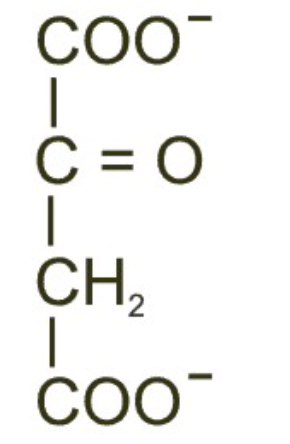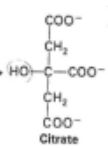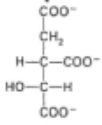TCA/link reaction (pyruvate -> Acetyl CoA)
1/69
There's no tags or description
Looks like no tags are added yet.
Name | Mastery | Learn | Test | Matching | Spaced |
|---|
No study sessions yet.
70 Terms
Explain what happens briefly in the Citric Acid Cycle.
Addition of Acetyl-coA to a 4C organic acid to form a 6C organic acid
6C -> 5C -> 4C, then the 4C compound is converted back to original 4C acid
Involves removal of hydrogens to generate reduced coenzyme
addition of OH and H groups by hydration of double bonds and decarboxylation
1 GTP is produced
none of the oxidation reactions in the TCA involve
molecular oxygen
in the TCA there is a net addition of oxygen, added as -
OH in water
the citric acid cycle occurs in the - of eukaryotes and is associated with the - in bacteria
mitochondria, cytoplasmic membrane
pyruvate is a product of - and can be converted to acetyl-CoA via -
glycolysis, oxidative decarboxylation
decarboxylation is -
irreversible
one glucose can produce - acetyl CoA molecules
two
three important sources of acetyl-CoA
decarboxylation of pyruvate from CHO, fatty acids, amino acids
breakdown of fatty acids
breakdown of leucine
the TCA cycle can metabolize the carbon skeletons of amino acids that are NOT broken down to acetyl-CoA by being converting them into - such as - (five things)
intermediates of the TCA cycle; pyruvate, α-ketoglutarate, succinyl-CoA, fumarate, or oxaloacetate
structure of oxaloacetate

structure of citrate

structure of isocitrate

structure of α-ketoglutarate

structure of cis-aconitate

structure of succinyl CoA

structure of succinate

structure of fumarate

structure of malate

order of acids in the TCA cycle
oxaloacetate
citrate
cis-aconitate
isocitrate
α-ketoglutarate
succinyl-CoA
succinate
fumarate
malate
oxaloacetate → citrate enzyme?
citrate synthase
citrate → cis-aconitate → isocitrate enzyme?
aconitase
isocitrate → α-ketoglutarate emzyme?
isocitrate dehydrogenase
α-ketoglutarate → succinyl CoA
α-ketoglutarate dehydrogenase complex
succinyl CoA → succinate enzyme?
succinyl CoA synthetase
succinate → fumarate enzyme?
succinate dehydrogenase
fumarate → malate enzyme?
fumarase
malate → oxaloacetate enzyme?
malase dehydrogenase
in the TCA cycle, which substrates are 6C?
citrate, cis-aconitate, isocitrate
in the cycle, which substrate is 5C?
alpha-ketogluterate
in the TCA cycle, which substrates are 4C?
succinyl-CoA, succinate, fumarate, malate, oxaloacetate
Which steps in the TCA cycle is there a loss of CO2?
isocitrate → alpha-ketogluterate
alpha-ketogluterate → succinyl-CoA
citrate synthase catalyzes the - of acetyl-CoA and oxaloacetate to form -. This reaction is - and highly exergonic
condensation, citrate, irreversible
aconitase converts citrate into - through a two-step reaction involving the intermediate -. This reaction facilitates the rearrangement of the - group for subsequent -
isocitrate, cis-aconitate, hydroxyl, oxidation
isocitrate dehydrogenase catalyzes the - and - of isocitrate to form -. This reaction also produces - and releases -
oxidation, decarboxylation, α-ketoglutarate, NADH, CO2
α-ketoglutarate dehydrogenase catalyzes the - of α-ketoglutarate to form -. This step generates - and releases -
oxidative decarboxylation, succinyl-CoA, NADH, CO2
succinyl-CoA synthetase converts succinyl-CoA into -, coupled with the production of -. This is the only - step in the cycle
succinate, GTP, substrate-level phosphorylation
succinate dehydrogenase catalyzes the - of succinate to -, producing -
oxidation, fumarate, FADH2
fumarase hydrates fumarate to form -
malate
malate dehydrogenase catalyzes the - of malate to regenerate -, producing - in the process
oxidation, oxaloacetate, NADH
in aerobic organisms the citric acid cycle can only function in aerobic tissue because the - must be regenerated by the -
reduced coenzymes, ETC
which steps in the TCA cycle are NADH and FADH2 formed?
isocitrate dehydrogenase, succinate dehydrogenase, malase dehydrogenase
which step in the TCA cycle is GTP formed?
succinyl synthetase
BeriBeri?
a disease caused by - deficiency and it was a serious health problem in the far east because - has a low content of -
thiamine, white rice, thiamine
thiamine pyrophosphate TPP is a prosthetic group of 3 important enzymes
pyruvate dehydrogenase
α-ketoglutarate dehydrogenase complex
transketolase
the function of lipoamide prosthetic group
hold pool of acetyl groups and transfers between enzyme subunits in pyruvate dehydrogenase complex
what are some biosynthetic precursors which are derived from the citric acid intermediates? (remember at least three)
citrate → fatty acids, sterols
alpha-ketogluterate → glutamate → other AA, purines
succinyl CoA → heme, chlorophyll
malate → pyruvate
oxaloacetate → PEP, aspartate →other AA, purines, pyrmidines
two AA and the citric acid intermediates from which they are immediately derived from
alpha-ketogluterate → glutamate
oxaloacetate → aspartate
- can be fed into the citric acid cycle to form cycle intermedaites
carbon chains of amino acids
what happens in glyoxylate cycle?
allows production of glucose from acetyl-CoA
bypasses the decarboxylation steps in citric acid cycle
involves addition of a second acetyl CoA
the net affect is the production of a new 4C succinate with each turn of the cycle
What are the two enzymes that form the bypass between isocitrate and malate.
malate synthase
isocitrate lyase
briefly describe the reaction used to form acetyl-CoA from acetate
synthesize AcCoA from acetate and CoA by an ATP-dependent reaction using acetyl CoA synthetase aka AMP

the main fate of succinate produced by glyoxylate cycle?
ultimately becomes oxaloacetate used for gluconeogenesis and other uses
Briefly describe the role of isocitrate as the branch point between the citric acid cycle and the glyoxylate cycle (what are the two possible reactions)
isocitrate dehydrogenase of TCA→ α-ketoglutarate
isocitrate lyase of glyoxylate cycle→ succinate and glyoxylate
availability of isocitrate and the competing enzymes determine which way the pathway will proceed
The - level influences the choice between the pathways
if energy is low, isocitrate → -
if energy is high, isocitrate → - → -
ATP/ADP
alpha-ketogluterate
glyoxylate + succinate, gluconeogenesis
citric acid cycle is regulated to provide the correct balance between - needs and - needs
energy, precursor
the enzyme that is regulated to control the amount of acetyl-CoA produced from pyruvate is
pyruvate dehydrogenase complex
inhibition of pyruvate dehydrogenase complex by - inactivates PDH complex
PDKinase phosphorylation
PDH complex becomes inactive when a specific - residue of pyruvate dehydrogenase is -
serine, phosphorylated
high ratios of (three) can enhance phosphorylation of a specific serine residue, resulting in - of PDH complex
acetyl CoA/CoA, NADH/NAD+, and ATP/ADP; inactivation
phosphorylation of specific serine residue on PDH complex is inhibited by - or -
pyruvate, analogues
PDH complex becomes active again when a specific - hydrolyzes the P
dephosphorylation is enhanced by an increase in - and -
phosphatase
Ca++, insulin
the three main enzymes that are regulated to control the rate of citric acid cycle?
citrate synthase
isocitrate dehydrogenase
alpha-ketogluterate dehydrogenase
- is an inhibitor of citrate synthase
ATP
(three) are mutually cooperative stimulators of isocitrate dehydrogenase
NAD+, Mg++, and ADP
(two) are inhibitors of isocitrate dehydrogenase
ATP and NADH
(three) are inhibitors of alpha-ketogluterate dehydrogenase
succinyl CoA, NADH, and high energy charge
it is possible for the two sides of the TCA cycle to run in opposite directions by
???
the rate of citrate synthase can be regulated with concentration of (two)
high levels of - will promote citrate synthase activity
high levels of - will inhibit citrate synthase activity
substrate and product
oxaloacetate
citrate
any - reaction will overcome the regulation of citrate synthase as they will increase supply of -
anaplerotic, TCA cycle intermediates
it is logical for the TCA cycle to be inhibited by ATP because when ATP levels are -, there is no need for continued -
high, ATP production